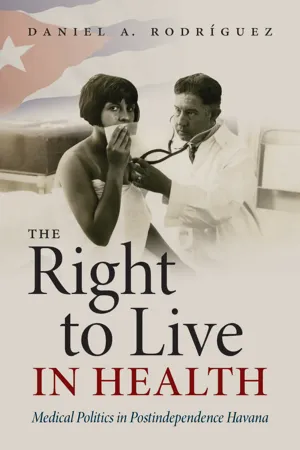![]()
NOTES
ABBREVIATIONS
| ANC | Archivo Nacional de Cuba, La Habana, Havana, Cuba |
| AH | Audencia de la Habana |
| CPRC | Citizens’ Permanent Relief Committee Records |
| FE | Fondo Especial |
| HFP | Homer Folks Papers, Columbia University Archives, New York, N.Y. |
| HSP | Historical Society of Pennsylvania, Philadelphia |
| LOC | Library of Congress, Manuscripts Division, Washington, D.C. |
| MGC | Records of the Military Government of Cuba, 1898–1903 |
| RA | Registro de Asociaciones |
| SP | Secretaría de la Presidencia |
| USNA | National Archives of the United States of America, College Park, Md. |
| UVA-SP | Library of the University of Virginia, Special Collections Library, Papers of Jefferson Randolph Kean |
INTRODUCTION
1. Congreso de la República de Cuba, Diario de sesiones del Congreso.
2. Congreso de la República de Cuba, Diario de sesiones del Congreso, 90.
3. Congreso de la República de Cuba, Diario de sesiones del Congreso, 91.
4. Congreso de la República de Cuba, Diario de sesiones del Congreso, 92.
5. Departamento de Sanidad de la Habana, Manual de práctica sanitaria, iii.
6. Tomes, Gospel of Germs; Wangensteen and Wangensteen, Rise of Surgery; Rosner, A Once Charitable Enterprise; Starr, Social Transformation of American Medicine; Rosenberg, Care of Strangers; Worboys, Spreading Germs.
7. See Ferrer, Insurgent Cuba; Fischer, Modernity Disavowed; Ferrer, Freedom’s Mirror; Finch, Rethinking Slave Rebellion in Cuba; and Childs, 1812 Aponte Rebellion.
8. See Tone, War and Genocide in Cuba, and Barcia Zequeira, Una sociedad en crisis.
9. Espinosa, Epidemic Invasions; Stepan, “Interplay between Socio-Economic Factors and Medical Science.” On the colonial politics of U.S. public health work abroad, see also Anderson, Colonial Pathologies; Birn, Marriage of Convenience; Laveaga, Jungle Laboratories; Palmer, Launching Global Health; and McCoy and Scarano, Colonial Crucible, 273–326.
10. On postindependence Cuban medicine, see Funes Monzote, El despertar del asociacionismo científico en Cuba; Naranjo Orovio and García González, Medicina y racismo en Cuba; García González and Álvarez Peláez, En busca de la raza perfecta; Palmer, “Beginnings of Cuban Bacteriology”; Gutiérrez, “Disease, Empire, and Modernity in the Caribbean”; Lambe, Madhouse; Urban, “The Sick Republic” and “The ‘Black Plague’”; and Rodríguez Expósito, “La Primera Secretaría de Sanidad,” Carlos J. Finlay, and Dr. Juan N. Dávalos. See also the work of Gregorio Delgado García, editor and major contributor of Cuba’s Cuadernos de la Historia de la Salud Pública.
11. Indeed, these circuits have been at the center of both the Atlantic and Caribbean history fields. See, for example, Scott, Common Wind; Ferreira, Cross Cultural Exchange in the Atlantic World; Rodgers, Atlantic Crossings; Putnam, Radical Moves; and Ferrer, Freedom’s Mirror.
12. On the disease implications of these Atlantic and circum-Caribbean interconnections, see Espinosa, Epidemic Invasions; Markel, Quarantine!; Echenberg, Plague Ports; Palmer, Launching Global Health; Kraut, Silent Travelers; De Barros, Palmer, and Wright, Health and Medicine in the Circum-Caribbean; and McNeill, Mosquito Empires.
13. Among the very few works on Spanish immigrants in Cuba, see Iturria, Españoles en la cultura cubana; Maluquer de Motes Bernet, Nación e inmigración; and Naranjo Orovio and García González, Medicina y racismo en Cuba.
14. On nineteenth- and twentieth-century urban growth, housing, and poverty in Havana, see Bay y Sevilla, La vivienda del pobre; Chailloux Cardona, Síntesis histórica de la vivienda popular; Scarpaci, Segre, and Coyula, Havana; García, Beyond the Walled City; and Horst, “Sleeping on the Ashes.”
15. Scarpaci, Segre, and Coyula, Havana, 43–45.
16. “Sanitation Files Ruined by Flames Started by Arson,” Havana Post, February 7, 1933; “Spain Acts to Help Youth Seized in Cuba,” New York Times, February 7, 1933.
17. “Bomb Blast at Havana Laboratory,” New York Times, December 18, 1932.
18. Antoinette Burton, “Archive Fever, Archive Stories,” in Burton, Archive Stories, 6. See also Trouillot, Silencing the Past, and Stoler, Along the Archival Grain.
19. See, for example, Thomas, Cuba; Ruiz, Cuba; Suchlicki, Cuba, from Columbus to Castro; Pérez, Cuba under the Platt Amendment; and Helg, Our Rightful Share.
20. Palmer, Piqueras, and Sánchez Cobos, State of Ambiguity; Pappademos, Black Political Activism and the Cuban Republic; Riaño San Marful, Gallos y toros en Cuba; Joseph and Nugent, Everyday Forms of State Formation; Sanders, Vanguard of the Atlantic World; Thurner and Guerrero, After Spanish Rule; Thurner, From Two Republics to One Divided; Adelman, Colonial Legacies; Mallon, Peasant and Nation.
21. Foucault, Birth of the Clinic; Tomes, Gospel of Germs; Anderson, Colonial Pathologies; Rogaski, Hygienic Modernity; Meade, Civilizing Rio; McKiernan-González, Fevered Measures; Markel, Quarantine!
22. This book is in close conversation with recent scholarship that looks at struggles over social rights in twentieth-century Latin America, such as Grandin, Last Colonial Massacre; Fischer, Poverty of Rights; Caulfield, In Defense of Honor; Suárez Findlay, Imposing Decency; Adair, In Search of the “Lost Decade”; Romero Sanchez, The Building State; and McDonald, “Peripheral Citizenship.” This work is also indebted to recent scholarship on postcolonial states that looks at how rights were negotiated and contested. See Chambers, From Subjects to Citizens; Ahlman, Living with Nkrumahism; Ahmed, Afghanistan Rising; and Mitchell, Rule of Experts.
23. Brotherton, Revolutionary Medicine.
CHAPTER ONE
1. Parker, Cubans of To-day, 487.
2. Delfín, Treinta años de médico, 7–12
3. Cuba’s third and final War of Independence from Spanish rule began in early 1895. The initial War of Independence, known as the Ten Years’ War, was fought between 1868 and 1878 and was followed by the short-lived Guerra Chiquita, or Little War (1879–80).
4. “Dispensario La Caridad,” Diario de la Marina, November 15, 1899.
5. On the difficulty of assessing the numbers of those killed or displaced by the final War of Independence, see Tone, War and Genocide in Cuba, 209–17.
6. See Tone, War and Genocide in Cuba, 223.
7. See Tyrell, Reforming the World.
8. “Doomed to Die of Starvation,” San Francisco Chronicle, April 26, ...
